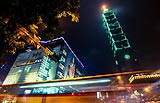Chinese orbiter staying in space for tests
Updated: 2014-12-03 07:40
By Luo Wangshu(China Daily)
|
||||||||
China's lunar orbiter continues to undergo tests in space after the return capsule landed on Earth, preparing for a future landing on the moon by Chang'e 5.
When the return capsule of the lunar orbiter separated from the service module and landed in Siziwang Banner of the Inner Mongolia autonomous region on Nov 1, the service module continued its mission to the moon, arriving at Lagrangian Point L2 on Saturday - an orbiting position of neutral gravity near the side of the moon farthest from the sun, where Chang'e 3 circled before.
"To take maximum advantage of the capacity of the service module to test relevant technologies for Chang'e 5, we are conducting a series of experiments on the service module, including circling the Lagrangian Point L2 and carrying equipment for experiments in orbit," said Pei Zhaoyu, deputy director of the China National Space Administration.
The module carries equipment including GPS, a high-resolution camera and a star sensor.
Pei said the test could validate technologies for Chang'e 5.
The camera, which boasts double normal resolution, can observe areas where Chang'e 5 will take samples. "These possible results can strengthen our confidence for Chang'e 5's landing," Pei said.
The service module is scheduled to leave L2 at the beginning of January and head to the moon. It will prepare for braking at peri-lune - the point at which an orbiting object is nearest the moon - and enter the moon's orbit in mid-January.
The other part of the orbiter, the return capsule, completed its mission a month ago, landing precisely as planned in the Inner Mongolia autonomous region.
The mission made China the third nation in the world to travel to the moon and back, following the Soviet Union and the United States.
The orbiter traversed 840,000 kilometers on an eight-day mission that saw it round the far side of the moon and take some incredible pictures of Earth and its moon together.
The mission also solved certain problems in re-entry technology. "It is like a car braking, but at a speed of 11.2 kilometers per second," said Zhang Wu, a designer of the lunar orbiter.
luowangshu@chinadaily.com.cn

 China, Brazil pledge to promote science, technology co-op
China, Brazil pledge to promote science, technology co-op
 ZTE, NBA team partners in business, charity
ZTE, NBA team partners in business, charity
 'Big' Peking opera staged in New York
'Big' Peking opera staged in New York
 250 Santas hit slopes for charity
250 Santas hit slopes for charity
 Jack Ma awarded Honorary Chairman of Zhejiang Chamber of Commerce
Jack Ma awarded Honorary Chairman of Zhejiang Chamber of Commerce
 2014 Yearender: Life underground
2014 Yearender: Life underground
 South China's 'little Africa'
South China's 'little Africa'
 Trending: Eiffel Tower replica in Hangzhou
Trending: Eiffel Tower replica in Hangzhou
Most Viewed
Editor's Picks

|

|

|

|

|

|
Today's Top News
Illinois university signs agreements with Chinese college
ZTE, NBA team partner in business, charity
Chinese investors in Brazil told to avoid risks
Economists call for increased public spending in China
Xiaomi's smartphone taps into US market
Peruvian product hit in Chinese market
Chinese role expected in Mexico's energy reform
Brazil film festival delights Beijing and Shanghai
US Weekly

|

|








